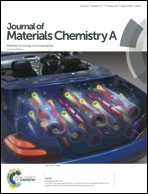Co-assembly of photosystem II in nanotubular indium–tin oxide multilayer films templated by cellulose substance for photocurrent generation†
Abstract
Photosystem II (PSII), as the only enzyme to catalyze the light-induced water oxidation reaction in the natural photosynthesis system, is introduced to fabricate artificial solar conversion systems with an intensive photo-to-current efficiency to convert solar energy into electrical power. In this research, we report a hybrid photo-bioelectrochemical system consisting of PSII isolated from spinach leaves that is co-assembled in nanotubular indium–tin oxide (ITO) multilayer films pasted on the commercial ITO substrate as a photoanode, which presents enhanced photocurrent responses as high as 2.4 μA cm−2 (mediator-free) and 39 μA cm−2 (with mediator) under white light irradiation (λ < 800 nm) using a xenon lamp as the light source. In this photoanode system, the three-dimensional (3D) hierarchical porous nanotubular ITO film was synthesized through a layer-by-layer (LBL) self-assembly process using a natural cellulose substance (e.g., filter paper) as a template. The specific structure, and good optical and electrical properties of the hierarchical nanotubular ITO allow for an increased protein loading as high as 166 pmol PSII cm−2 and an enhanced photocurrent by about 78 times compared with the bare PSII photoanode. This biomimetic template fabrication method of ITO materials with unique morphologies and desirable properties provides an effective assembly strategy for PSII-based hybrid photoanode systems for solar energy conversion.



 Please wait while we load your content...
Please wait while we load your content...